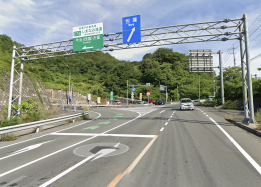
MapCode :
48 248 164*40
Website :
Description :
Beginning point at north entrance to the Shimanami Kaido in Onomichi, Hiroshima Prefecture. The highway is approximately 70 km / 44 mi long, ending in Imabari, Ehimi Prefecture on Shikoku Island. It is also called the Nishi-Seto Expressway. The route, opened in 1999, crosses six smaller islands between Honshu and Shikoku. There is also a separate foot and bike road totalling about 70 km (? mi). There is a total of about 5,000 yen in tolls to cross the complete highway.
Hours :
Open daily 24/7
Address :
1-1 Higashigoshochō, Onomichi, Hiroshima 722-0036
3.1
km / 1.9
miles
-
(3
minutes)


Min/Max Time :
5 / 10
Minutes
MapCode :
48 251 698*03
Phone :
078-291-1033
Description :
The Shin-Onomichio Bridge is a modern, divided highway bridge crossing from Onomichi City (on the island of Honshu) to Mukaishima Island (connecting to the island of Shikoku) in the Seto Inland Sea. It was opened in 1999, approximately 30 years after the nearby Onomichi bridge which was the first cable stayed bridge in Japan. The bridges are of similar, three-span design with a center span of 215 m (705 ft). Note that bicycle traffic is forbidden on this bridge as there is no separate sidewalk.
Hours :
Open daily 24/7
Address :
Mukaihigashicho, Onomichi, Hiroshima 722-0062, Japan
7.3
km / 4.5
miles
-
(6
minutes)
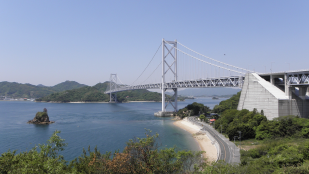
Min/Max Time :
5 / 10
Minutes
MapCode :
48 066 479*55
Description :
The Innoshima Bridge is a Japanese suspension bridge, part of the 59 km / 37 mi Nishiseto Expressway linking the islands of Honshu and Shikoku. Completed in 1983, it has a main span of 770 m / 2,526 ft and connects Mukaishima, Hiroshima with Innoshima, Hiroshima.
Courtesy of Wikipedia
Courtesy of Wikipedia
Hours :
Open daily 24/7
Address :
Onomichi, Hiroshima
7.5
km / 4.6
miles
-
(6
minutes)

Min/Max Time :
5 / 10
Minutes
MapCode :
381 798 038*17
Description :
The Ikuchi Bridge, connecting Innoshima Island with Ikuchi Island, was completed in 1991 as the fifth long-span bridge on Nishi-Seto Expressway. This bridge was the longest cable stayed bridge in the world when completed. The particular characteristic of the bridge is to have applied heavy concrete girders at the side spans of the bridge and light steel girders at the center span as so called composite structures. Various techniques applied to the Ikuchi Bridge were made use of in constructing the Tatara Bridge which is the second longest cable stayed bridge in the world.
Courtesy of Honshu-Shikoku Bridge Expressway Company Ltd.
Courtesy of Honshu-Shikoku Bridge Expressway Company Ltd.
Hours :
Open daily 24/7
Address :
Innoshimasunoecho, Onomichi, Hiroshima 722-0000
10.2
km / 6.3
miles
-
(9
minutes)
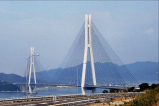
Min/Max Time :
5 / 15
Minutes
MapCode :
154 323 690*00
Phone :
078-291-1033
Description :
The Tatara Bridge is a cable-stayed bridge that is part of the Nishiseto Expressway, commonly known as the Shimanami Kaidō. The bridge has a center span of 890 m / 2,920 ft. As of 2010 it has the fourth longest main span of any cable-stayed bridge after the Sutong Bridge in China. The expressway is a series of roads and bridges that is one of the three routes of the Honshū-Shikoku Bridge Project connecting the islands of Honshū and Shikoku across the Seto Inland Sea in Japan. The bridge, which opened on May 1, 1999, carries two lanes of traffic in each direction and has additional lanes for bicycles, motor bikes, and pedestrians.
Courtesy of Wikipedia
Courtesy of Wikipedia
Hours :
Open daily 24/7
Address :
Setodachoogi, Onomichi, Hiroshima 722-2403
6.2
km / 3.8
miles
-
(5
minutes)
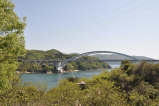
Min/Max Time :
5 / 10
Minutes
MapCode :
154 172 452*50
Description :
The Omishima Bridge crosses Hanaguri Seto between Omishima Island and Hakata Island. This bridge is the only arch bridge crossing the Seto Inland Sea. This Bridge was the first bridge completed as part of the Honshu-Shikoku Bridges project.
The arch length of the bridge was the longest one in Japan at that time. The color, light gray, of painting, materials and construction method of pavement, etc. of the Bridge were applied for other bridges in the Honshu-Shikoku Bridges.
i>Courtesy of Honshu-Shikoku Bridge Expressway Company Ltd.
The arch length of the bridge was the longest one in Japan at that time. The color, light gray, of painting, materials and construction method of pavement, etc. of the Bridge were applied for other bridges in the Honshu-Shikoku Bridges.
i>Courtesy of Honshu-Shikoku Bridge Expressway Company Ltd.
Hours :
Open daily 24/7
Address :
Hakatacho Ikata, Imabari, Ehime 794-2303
4.1
km / 2.6
miles
-
(3
minutes)
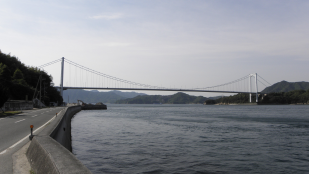
Min/Max Time :
5 / 10
Minutes
MapCode :
154 084 630*17
Description :
The Hakata–Ōshima Bridge is a Japanese suspension bridge, part of the 59 km / 37 mi Nishiseto Expressway connecting the islands of Honshū and Shikoku. Completed in 1988, it has a main span of 560 m / 1,837 ft and connects Hakatajima with Ōshima.
Courtesy of Wikipedia
Courtesy of Wikipedia
Hours :
Open daily 24/7
Address :
Miyakubocho Miyakubo, Imabari, Ehime 794-2203
12.6
km / 7.8
miles
-
(12
minutes)

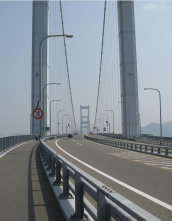
Min/Max Time :
10 / 30
Minutes
MapCode :
381 120 067*22
Phone :
078-291-1033
Description :
The Kurushima Strait Bridge is actually made up of three sections of suspension bridges, connecting several smaller islands connecting the various islands between Shikoku and Honshu. It is the world's longest series of suspension bridges.
Courtesy of Wikipedia
Courtesy of Wikipedia
Hours :
Open daily 24/7
Address :
Umashima, Imabari, Ehime 799-2123
7.2
km / 4.5
miles
-
(9
minutes)
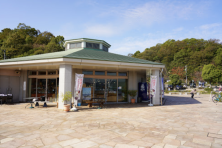
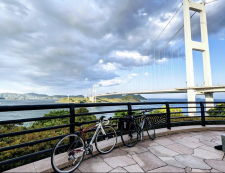
MapCode :
356 417 286*68
Phone :
089-841-5002
Website :
Description :
The Kurushima Strait Observatory not only provides fantastic views of the Kurushima Strait and the 3 Kurushima Strait Bridges, but it provides a nice rest top for an ice cream or other snack as well as other shopping needs.
Hours :
Open daily 09:00 – 18:00
Address :
2 Chome-5 Kouracho, Imabari, Ehime 799-2111, Japan